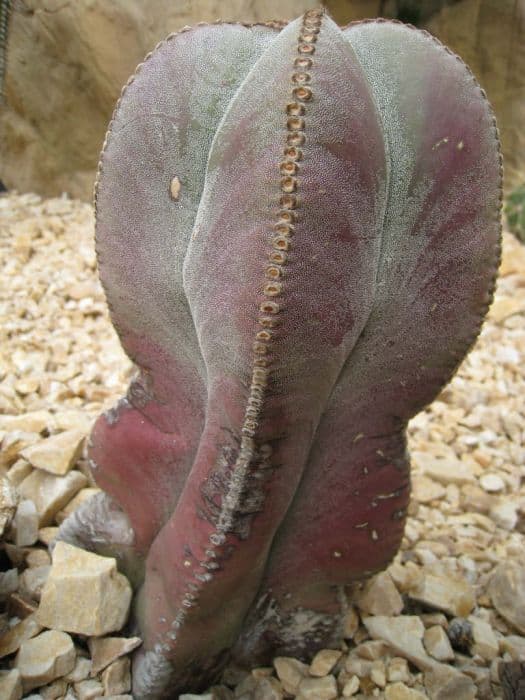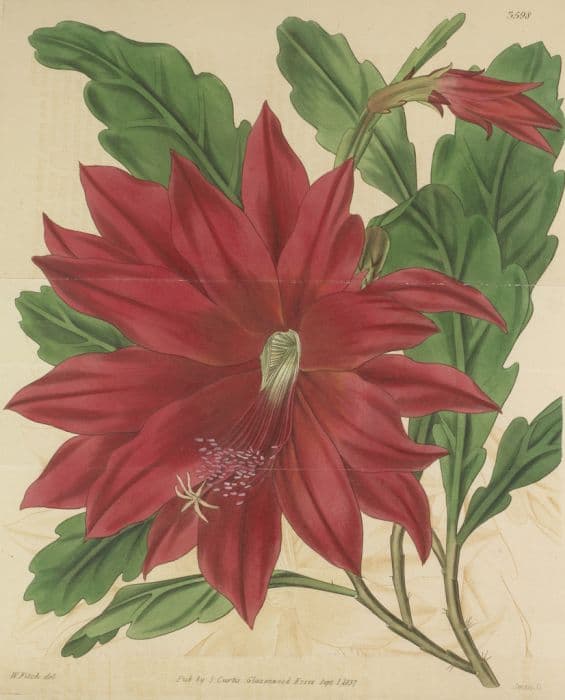Bunny Ears Cactus Opuntia microdasys

ABOUT
The bunny ear cactus, as commonly known, possesses a unique and whimsical appearance, with pad-like segments that give the impression of rabbit ears. The surface of these green segments is dotted with numerous small, whitish-yellow glochids, which look like small tufts of fur. These glochids are in fact tiny spines that can easily detach and stick to the skin, a defense mechanism against predators. The plant branches profusely, forming clusters of pads that create a dense and bushy appearance. During the blooming season, the bunny ear cactus can produce small yellow flowers that add a touch of contrasting color to the green pads, though the flowers are less commonly noticed than the distinctive pads themselves.
About this plant
 Names
NamesFamily
Cactaceae.
Synonyms
Bunny Ears Cactus, Polka-dot Cactus, Angel's Wings, Bunny Cactus, Mickey Mouse Cactus, Bunny Ears Prickly Pear.
Common names
Opuntia microdasys var. albispina, Opuntia microdasys var. pallida, Opuntia microdasys var. rufida, Cactus microdasys, Opuntia tesajo.
 Toxicity
ToxicityTo humans
The Bunny Ears cactus contains tiny, hair-like glochids that can detach easily and cause skin irritation upon contact. While not toxic if ingested, the physical irritation and potential for injury from the spines and glochids should be considered when handling the plant. If the glochids are ingested, they could cause irritation to the mouth and throat. There are no inherent poisons in the plant that lead to systemic toxic effects upon ingestion.
To pets
Similar to its effects on humans, the Bunny Ears cactus is not toxic to pets if ingested. However, the fine, barbed glochids can cause irritation and discomfort to pets if they come into contact with or attempt to eat the plant. These glochids can get stuck in the skin, mouth, throat, or gastrointestinal tract of pets, leading to irritation and potential complications if not properly treated. It's important to keep pets away from the plant to prevent these mechanical injuries.
 Characteristics
CharacteristicsLife cycle
Perennials
Foliage type
Evergreen
Color of leaves
Green
Flower color
Yellow
Height
2 feet [60cm]
Spread
4 feet [120cm]
Plant type
Cactus
Hardiness zones
9
Native area
Mexico
Benefits
 General Benefits
General Benefits- Easy to Care For: Opuntia microdasys, commonly known as Bunny Ear Cactus, is a low-maintenance plant suitable for novice gardeners.
- Drought-Tolerant: The Bunny Ear Cactus is well-adapted to dry conditions, requiring minimal watering.
- Ornamental Value: With its distinctive pad-like stems that resemble rabbit ears, it adds visual interest to a variety of landscape designs.
- Indoor & Outdoor Versatility: It can be grown both indoors as a houseplant and outdoors in suitable climates.
- Propagation Ease: The cactus can be easily propagated from cuttings, making it simple to expand your collection or share with others.
- Pest Resistance: The Bunny Ear Cactus is relatively resistant to pests, which reduces the need for chemical treatments.
- Long Lifespan: When cared for properly, this cactus can live for many years, providing long-term enjoyment.
 Medical Properties
Medical Properties- Anti-inflammatory: Opuntia microdasys extracts have been studied for their potential anti-inflammatory effects.
- Antioxidant: The plant contains antioxidants that may help in reducing oxidative stress.
- Wound healing: Some studies suggest that Opuntia species may have properties that can aid in the wound healing process.
- Antiviral: Compounds in Opuntia microdasys may exhibit antiviral activity against certain viruses.
- Anti-diabetic: There is some evidence showing that Opuntia plants may help in the management of blood sugar levels.
- Hypolipidemic: Opuntia microdasys might aid in the reduction of lipid levels in the blood.
 Air-purifying Qualities
Air-purifying QualitiesThis plant is not specifically known for air purifying qualities.
 Other Uses
Other Uses- Ornamental Decoration: Bunny Ear cactus is often used in xeriscaping and succulent gardens for its distinctive shape and ease of care.
- Barrier Planting: The spines and dense growth pattern of the Bunny Ear cactus can make it an effective deterrent when planted as a barrier against small animals and trespassers.
- Education: It is used in educational settings to teach about desert plant adaptations, specifically how it stores water and protects itself with spines.
- Photography: With its unique appearance, the Bunny Ear cactus is a popular subject for botanical photographers and artists.
- Sound Insulation: Utilized in sound barrier walls and fences when grown densely, due to its mass and structure.
- Traditional Handicrafts: The woody spines have been used in some cultures to create small tools or as a part of weaving materials for traditional crafts.
- Erosion Control: The Bunny Ear cactus can be used to stabilize soil and prevent erosion in arid regions due to its widespread root system.
- Nature-Inspired Design: It is often used as an inspiration for biomimicry in design, influencing patterns and structures in architecture and textiles.
- Entomology: The plant can serve as a research subject in entomology to study insect-plant interactions, as it hosts cochineal insects.
- Vegetative Propagation Practice: Bunny Ear cactus is commonly used to demonstrate vegetative propagation techniques due to its ease of growing from cuttings.
Interesting Facts
 Feng Shui
Feng ShuiThe Bunny Ears Cactus is not used in Feng Shui practice.
 Zodiac Sign Compitability
Zodiac Sign CompitabilityThe Bunny Ears Cactus is not used in astrology practice.
 Plant Symbolism
Plant Symbolism- Resilience - Opuntia microdasys, commonly known as Bunny Ears Cactus, is symbolic of resilience due to its ability to thrive in harsh, arid environments where other plants might not survive.
- Protection - The cactus's spines can represent protection and defense against adversity or negative forces.
- Adaptability - Its capacity to store water and adapt to extreme conditions makes the Bunny Ears Cactus a symbol of adaptability and resourcefulness.
- Endurance - The plant signifies endurance as it can live for many years, enduring the challenges of its natural habitat.
- Self-Sufficiency - As a low-maintenance plant that requires minimal care to grow, Bunny Ears Cactus symbolizes self-sufficiency and independence.
 Water
WaterBunny Ears Cactus requires less water compared to other house plants. It should be watered when the top inch of the soil feels dry to the touch, approximately every 1 to 2 weeks during its growing season in spring and summer. In cooler months, reduce watering to once a month or less, as the plant goes into dormancy. Always water thoroughly until excess water drains out of the pot, but do not let the plant sit in standing water. Typically, you should provide between 4 to 8 ounces of water per watering session, depending on the size and container of your cactus.
 Light
LightBunny Ears Cactus thrives in bright, indirect sunlight but can also tolerate direct sunlight. The best spot for this plant is near a south-facing or east-facing window where it will receive plenty of light without the risk of getting scorched. If the light is too intense, it may require some light shading during the hottest parts of the day.
 Temperature
TemperatureBunny Ears Cactus prefers warm temperatures, ideally between 70°F and 100°F. It can withstand temperatures as low as 50°F, but it should not be exposed to frost or prolonged periods below this range, as it can damage the plant. The ideal condition is a consistent, warm temperature without sudden fluctuations.
 Pruning
PruningPruning Bunny Ears Cactus is generally done to remove damaged or diseased pads and to maintain its shape. Use a pair of tongs and sharp, sterilized scissors or pruning shears to cut the pads at the joint. Pruning is best done in the spring or early summer when the cactus is actively growing. It is typically not necessary to prune often, only when you see areas that need attention or to encourage a specific growth pattern.
 Cleaning
CleaningAs needed
 Soil
SoilThe Bunny Ears cactus requires a well-draining soil mix with a pH of about 6.0 to 7.5. An ideal soil mixture includes one part potting soil, two parts coarse sand, and one part perlite or pumice to ensure good drainage and aeration. Adding a bit of compost for nutrients can also be beneficial, but it should be kept to a minimum to avoid retaining excess moisture.
 Repotting
RepottingBunny Ears cacti should be repotted every two to three years or when it has outgrown its current pot. It's best to repot this plant in the spring or early summer during its active growing period. Ensure the new pot is only slightly larger to prevent water from lingering in the excess soil, which can lead to root rot.
 Humidity & Misting
Humidity & MistingBunny Ears cacti thrive best in low humidity environments, typically under 60%. These desert natives are adapted to dry conditions and excessive humidity can lead to fungal diseases and rot. Ideal indoor humidity conditions for this plant mimic its natural arid habitat.
 Suitable locations
Suitable locationsIndoor
Provide bright light, low humidity, and infrequent watering.
Outdoor
Place in full sun to partial shade, shelter from rain.
Hardiness zone
9-11 USDA
 Life cycle
Life cycleOpuntia microdasys, commonly known as the Bunny Ears Cactus, starts its life cycle as a seed that sprouts in well-draining, sandy or gravelly soil typical of its native desert habitat. The seedling stage is characterized by small pads that eventually grow into larger, flat, and oval pad-like stems, which perform photosynthesis. As the plant matures, it forms a clump of pads, and after some years, it develops small yellow flowers during spring or summer that are mostly pollinated by insects. Following pollination, the flowers turn into small red or purple fruits that contain seeds, ensuring the continuation of the species. The Bunny Ears Cactus is adapted to periods of drought, storing water in its pads, and can live for many years, growing new pads and flowering annually in the right conditions. Over time, older pads might wither and die as part of the natural growth cycle, but they are often replaced by newer growth ensuring the cactus's longevity.
 Propogation
PropogationPropogation time
Spring-Early Summer
Propogation: The Bunny Ear Cactus, also known as Opuntia microdasys, is typically propagated during the warmer seasons, spring and summer being the ideal times when the plant is actively growing. The most popular method of propagation for this cactus is through its pads. To propagate, a healthy pad is carefully removed from the parent plant, using gloves to protect against the tiny glochids. The pad should be allowed to form a callous over the cut area for about a week before planting. This reduces the risk of rot when the pad is placed in soil. Once calloused, the pad is planted in a well-draining cactus mix, inserting about an inch (approximately 2.54 cm) of the pad's base into the soil. It is important to keep the soil lightly moist and provide the cuttings with bright, indirect sunlight until they establish a strong root system.








